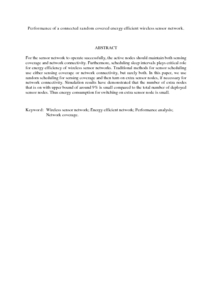Citation
Mahdavi, M. and Ismail, M. and Jumari, K. and Hanafi, Z. M.
(2009)
Performance of a connected random covered energy efficient wireless sensor network.
World Academy of Science, Engineering and Technology, 29.
pp. 660-664.
ISSN 2070-3724
Abstract
For the sensor network to operate successfully, the active nodes should maintain both sensing coverage and network connectivity. Furthermore, scheduling sleep intervals plays critical role for energy efficiency of wireless sensor networks. Traditional methods for sensor scheduling use either sensing coverage or network connectivity, but rarely both. In this paper, we use random scheduling for sensing coverage and then turn on extra sensor nodes, if necessary for network connectivity. Simulation results have demonstrated that the number of extra nodes that is on with upper bound of around 9% is small compared to the total number of deployed sensor nodes. Thus energy consumption for switching on extra sensor node is small.
Download File
![[img]](http://psasir.upm.edu.my/16134/1.hassmallThumbnailVersion/Performance%20of%20a%20connected%20random%20covered%20energy%20efficient%20wireless%20sensor%20network.pdf)  Preview |
|
PDF (Abstract)
Performance of a connected random covered energy efficient wireless sensor network.pdf
Download (83kB)
| Preview
|
|
Additional Metadata
Actions (login required)
 |
View Item |

